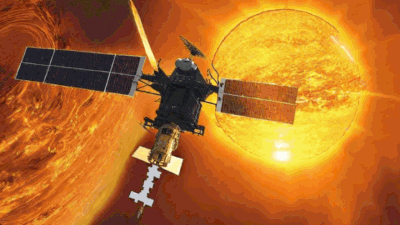"Aditya-L1: India's Solar Explorer"
Aditya-L1 is India's solar observation satellite, designed to study the Sun's corona and its effects on Earth's weather and climate. Equipped with UVIT, VELC, XSM, and a magnetometer, it aims to provide comprehensive data on solar radiation and magnetic dynamics. Its mission includes improving space weather prediction to safeguard Earth's infrastructure from solar events. Aditya-L1's collaborative nature promotes global space research efforts and inspires scientific literacy through outreach initiatives. This mission lays the groundwork for future solar research projects and advances India's competence in space exploration.

Humanity has always been fascinated by space, which has led to significant technological advancements and research to help us understand the mysteries that exist beyond our planet. Satellites play a crucial role in this endeavor as they can be used for various tasks, including communication and Earth's surveillance. One such satellite that has garnered attention, especially in the context of solar studies, is Aditya-L1, India's dedicated spacecraft for observing the Sun.
Origins and Objectives:
Aditya-L1 was developed by the Indian Space Research Organisation (ISRO) and named after the Hindu Sun God Aditya. The mission, approved in 2018, marks India's ambitious foray into solar observation. Aditya-L1's primary objectives are to monitor the Sun's corona, its outermost layer, and investigate the various aspects of solar activity that affect Earth's weather and climate. Scientists aim to better understand solar processes to forecast space weather events that can impact Earthly power networks, satellite communication systems, and navigation systems.
Technical Specifications:
Aditya-L1 is equipped with scientific tools designed to measure and examine various solar radiation characteristics. The satellite has an Ultra Violet Imaging Telescope (UVIT) for ultraviolet spectrum studies, and a Visible Emission Line Coronagraph (VELC) for imaging the solar corona in visible light. Together, these tools provide us with a comprehensive understanding of the Sun's outer atmosphere. A Solar X-ray Monitor (XSM) is another component of the project that measures the Sun's X-ray emissions to provide information about high-energy solar events. Having a magnetometer on board makes it possible to detect the solar magnetic field, thus advancing our knowledge of the magnetic dynamics of the Sun.
Significance of Space Weather Prediction:
Space weather, fueled by solar activity, significantly affects Earth's infrastructure and technological systems. Geomagnetic storms caused by solar flares, coronal mass ejections (CMEs), and other solar events have the potential to interfere with satellite communication, navigational systems, and power grids. Aditya-L1's observational capabilities aim to improve our understanding and prediction of these space weather phenomena. Scientists may create models to predict solar activity by observing the behavior of the Sun. This information is useful for preventing possible disturbances to Earth's technological systems.
Collaborative Efforts and Global Impact:
Although Aditya-L1 is an Indian mission, its influence transcends national borders. Global space organizations acknowledge the collaborative nature of solar research, and Aditya-L1 data will add to the body of knowledge about the Sun that is already available. International space research collaborations facilitate the exchange of knowledge and resources, advancing our understanding of the cosmos. Aditya-L1's data will be added to observations from other solar missions to paint a more complete picture of solar phenomena and their effects on the solar system.
Educating and Inspiring:
In addition to its scientific goals, Aditya-L1 has enormous potential for outreach and teaching programs. The project has the potential to motivate the upcoming generation of Indian and global scientists and space enthusiasts. Public talks, outreach initiatives, and educational programs on Aditya-L1 can be used as forums to introduce students and the wider public to the wonders of space travel. The mission promotes scientific literacy and piques people's enthusiasm about the cosmos by demystifying difficult scientific ideas and highlighting the practical uses of space exploration.
Future Prospects and Space Exploration:
Aditya-L1 establishes the groundwork for India's upcoming space exploration and solar research projects. The information acquired by Aditya-L1 will help create increasingly complex models and simulations as technology develops, which will help us comprehend the Sun's behavior even better. Furthermore, Aditya-L1's success opens the door for more ambitious solar missions that might involve cross-national cooperation and even more sophisticated instruments. Missions such as Aditya-L1 are crucial in establishing the capabilities and knowledge required for large-scale space exploration projects as humankind looks towards exploring the outer regions of the solar system and beyond.
In summary, Aditya-L1 is evidence of India's increasing competence in space exploration and its dedication to expanding scientific knowledge. The satellite's Sun-observing mission has great potential for deciphering the intricacies of solar activity and how it affects Earth. In addition to providing insightful data to the international scientific community, Aditya-L1 encourages a new generation of scientists to aim higher as it continues its space mission. Aditya-L1 is an important step forward in the field of space exploration, helping us understand the cosmos better.










































